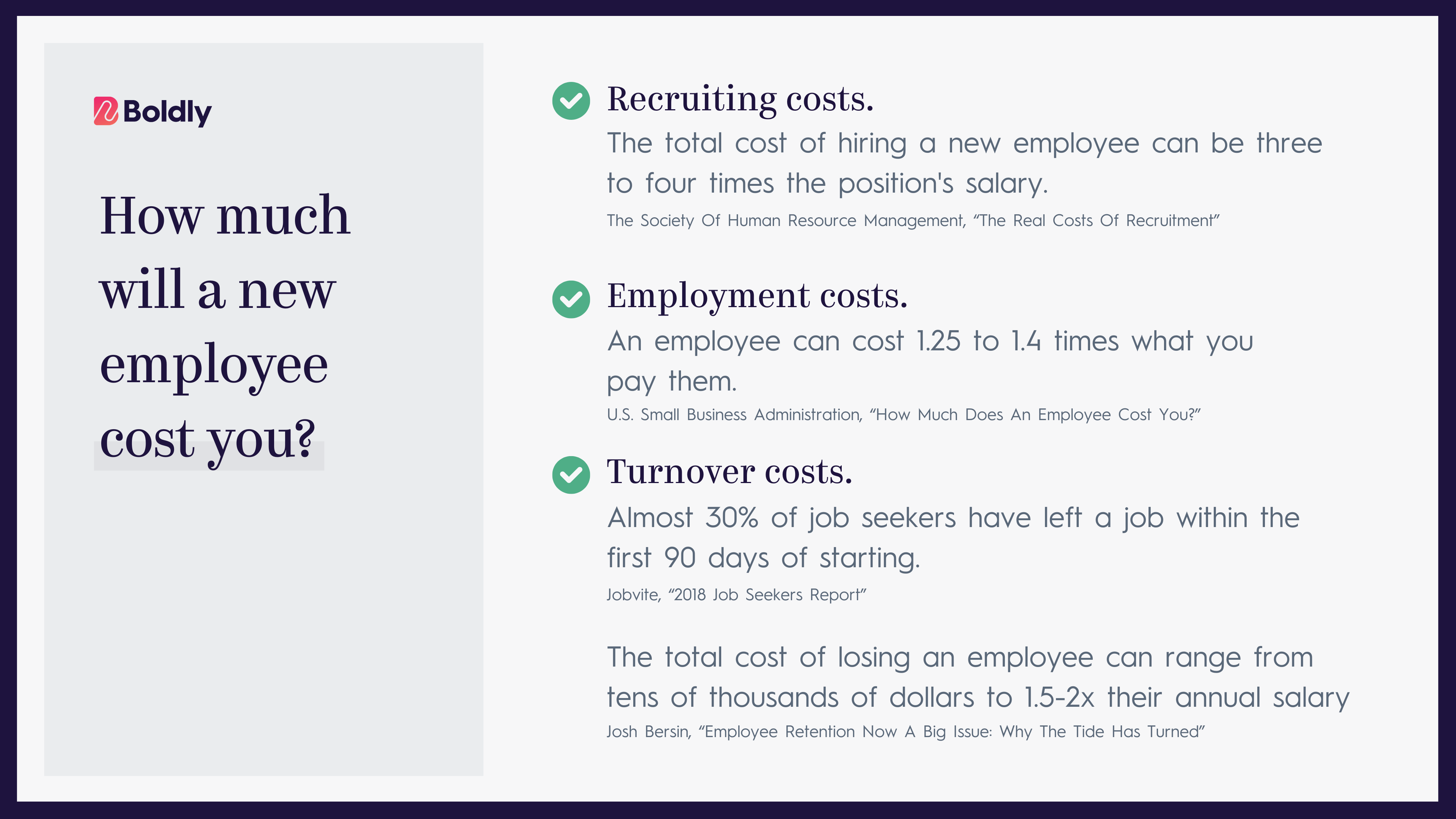Everything seems to cost more right now, including hiring.
If you’re still set on finding the traditional 9-5 in-office employee, you aren’t just missing out on the best talent; you’re actually working against your profit margins.
But there’s an expensive theme to these — you’re still on the hook to find, hire, and onboard. All of these take a significant investment of time and money.
If you think hiring costs are driving your profits down, we have a solution. But first, let’s get a better picture of the state of hiring right now.
What Hiring Full-Time Employees Costs


When you think of the costs associated with hiring a full-time employee, salary and benefits are what usually come to mind.
Compensation costs went up nearly 4% in Q1 2025, along with about a 4% increase in benefit costs. It’s easy to shrug and say that’s just the cost of doing business, but there are hidden costs that go along with hiring that are easily unnoticed.
The challenge becomes even more complex when you consider that traditional hiring often relies on local talent pools and conventional recruitment methods.
Many companies are discovering that remote recruitment agencies offer access to a broader range of qualified candidates, but even this approach comes with its own set of costs and time investments. With economic uncertainty reaching unprecedented levels in 2025, businesses need more flexible solutions.
One area where costs have particularly escalated is executive assistant salaries.
What once might have been a $45,000 position now commands $80,000, or more in many markets, especially when you factor in the competition for skilled administrative professionals.
This salary inflation, combined with the recruiting and onboarding costs we’re about to look at, creates a perfect storm for businesses trying to maintain profitability while accessing the support they need.
Beyond the obvious, there are three other costs to hiring that can set you back more than you might realize:
- The cost of recruiting
- The cost of onboarding
- The cost of employee turnover
The Cost Of Recruiting
Unlike onboarding and employee turnover (which we’ll cover next), recruiting costs involve “hard costs” that are easier to track.
This includes listings on job boards, interview costs, background checks, and other verification. These recruiting costs can run anywhere between $4700-$20K, depending on the position. And these recruitment costs increase when you’re hiring during a labor shortage.
Reducing recruiting efforts to save may bring problems down the road, particularly when competition for qualified applicants is fierce.
The Cost Of Onboarding
Onboarding and training are necessary for every employee. They need tools, secure access, systems training, and an understanding of company policy and culture.
The cost of onboarding and training new employees was nearly $1,300 back in 2015. Like everything else, that has trended significantly upward. These so-called “soft costs” today can be nearly 60% of the total hiring cost.
Soft costs in this case include not just the time spent training and the tools and materials necessary to do that, but also lost productivity as the new employee works to get up to speed. Even if a position is filled, it takes several months for the employee to be as productive as who they are replacing.
The Cost Of Employee Turnover
The Great Resignation that dominated headlines from 2021-2022 has finally started to cool down. In 2025, we’re seeing turnover rates return to more normal levels, similar to what we saw before the pandemic turned the job market upside down. Monthly quits have dropped to about 3.3 million Americans, down from over 4 million during the peak chaos of 2022.
But here’s the thing: even with turnover stabilizing, it’s still expensive when it happens.
Every year, businesses in the United States lose hundreds of billions of dollars to employee turnover. Replacing an employee costs 50-200% of their annual salary, depending on their position and training required.
That $60,000 employee who just walked out? It’ll cost you between $30-$120K to replace them.
Not only that, but when an employee leaves, it’s not just a position left open, but a person gone. A person who takes their skills and experience with them. The remaining team faces increased workloads during the transition, which can impact morale and productivity even in today’s more stable job market.
Are Hiring Costs Eating Into Your Profits?
You might think that hiring costs aren’t out of line, that they’re not to blame for profitability issues. That may be, but there’s only one way to know for sure, and that’s to actually run the numbers.
Calculate The Actual Costs
There are three pieces of data you’ll want to know to see what hiring is actually costing you.
- What is your cost per hire? Determine an average based on your most recent hires, considering recruitment and training costs.
- How long did it take you to fill the position? Determine the average time it takes to fill a position from when it is made available to when a new hire is officially signed on. If your company is hiring while scaling quickly, time is something you don’t have.
- What is your employee turnover rate? Calculate the rate at which employees leave your company voluntarily, based on total employees.
These three pieces of information will give you a better picture of how you’re doing with hiring. Employee turnover rate is an indicator of how often you’re going to incur those hiring costs.
Review Hiring Success
The next data you’ll collect won’t be as exacting as dealing with hard numbers, but it’s just as important to at least be taking a close look.
- What kind of impact on productivity happens with hiring? New employees who need extensive training, mentoring, or take up a lot of time for correction or guidance are robbing your company of productivity. They may not have been qualified or are a poor fit, and could negatively impact your team through increased workloads.
- Are you hiring quality candidates? This involves questions of retention, consistently high productivity, and cultural fit. High turnover is only one indicator of poor candidates.
- Have you created benchmarks to continuously measure success? Whether it’s using key performance indicators (KPIs) or other benchmarks, you want to compare what hiring does to profits. In theory, over time, a new hire should increase profit if everything goes well. But unnecessary hires, full-time employees who should be part-time, or high employee turnover will negate that. Benchmarks will let you know if your turnover rate is too high, or your hiring costs have exceeded what you can absorb.
Just as you would do with other costs, calculating what hiring actually costs your business is necessary to see if it’s to blame for profitability issues.
An Alternative To Hiring New Employees
An easier solution to hiring starts with a simple question: do you even need to hire someone in-house? Could outsourcing admin reduce costs?
A remote executive assistant might be your ideal solution, especially when you consider what remote work means for businesses today. It means access to top talent without geographic limitations, reduced overhead costs, and the flexibility to scale support as needed.
The rise of fractional assistants has fundamentally changed how businesses approach administrative support, offering a more cost-effective alternative to traditional hiring.
By using fractional staffing and paying only for the hours you need, you can:
- Get help almost immediately, skipping the expensive recruiting, interviewing, and onboarding.
- Access top-level talent that might not be within reach if you were hiring locally, including professionals who specifically seek remote executive assistant jobs for the flexibility and work-life balance they provide.
- Be ready to scale quickly and adjust as necessary without worrying about contracts or long-term commitments.
Instead of sacrificing profits or waiting to bring on needed help when the budget allows, you can fill the talent gaps on your team right now.
We’ve recently seen a huge increase in the number of companies looking for a fractional executive assistant. If this sounds like you, get in touch!




